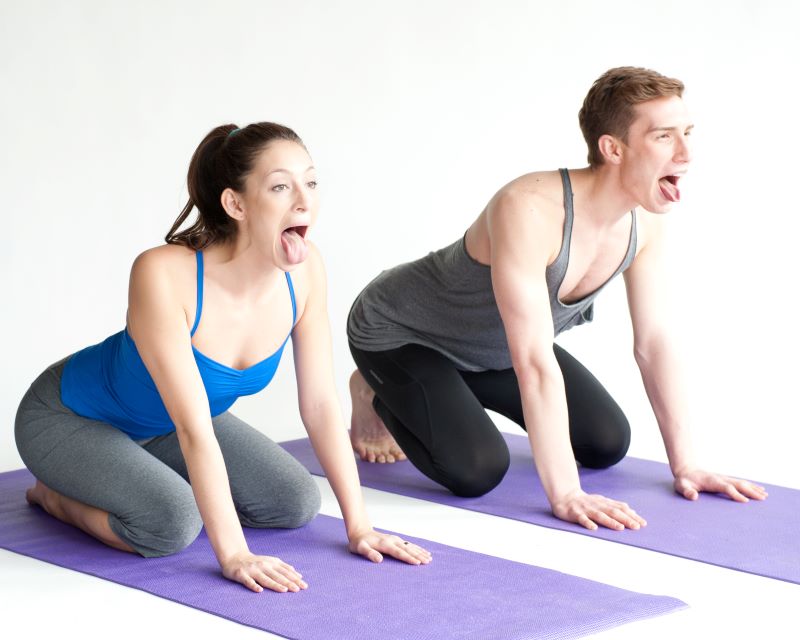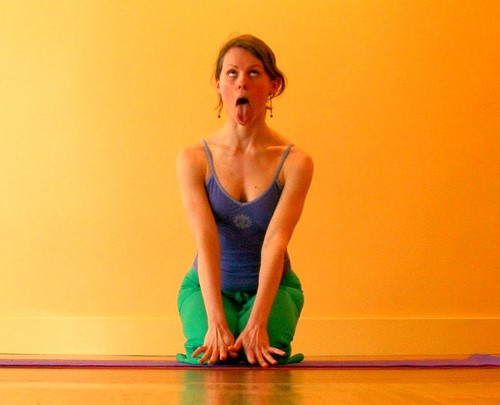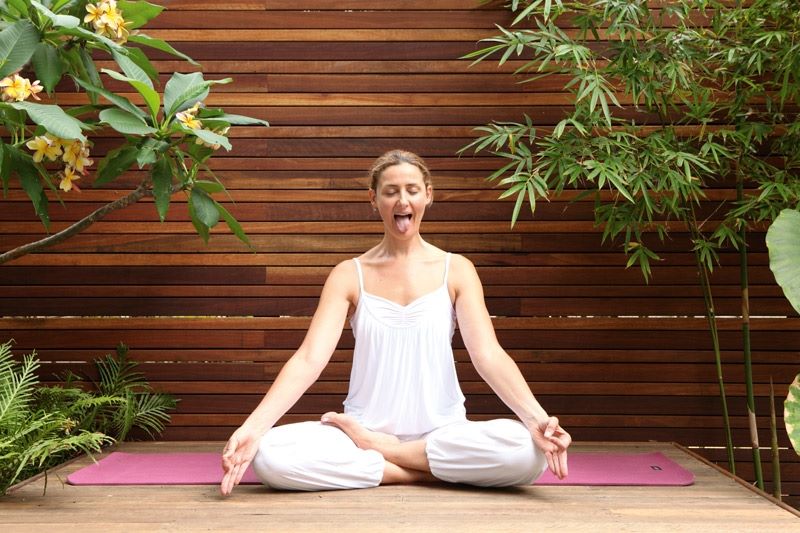15 Health Benefits of Simhasana & How to Do It?

Simhasana is a component of Hatha yoga and the contemporary yoga movement. Although it is one of the most unusual yoga postures, this asana has numerous health benefits.
This asana, which involves a distinctive facial expression and specific body movements, is designed to enhance physical health and mental well-being. Practising Simhasana regularly can help improve respiratory function, reduce stress, and promote overall vitality.

Table of Contents

What is Simhasana or Lion Pose?
Simhasana comprises two basic words: Simha, which means "lion," and asana, which means "position." It is carried out while seated with the hands facing up.
It is a powerful asana that helps with voice clarity and speech problems like stuttering. Additionally, it aids in lowering tension and irritability.
How to Perform Simhasana?

Steps to perform Simhasana, you can adhere to the following steps:
Step 1: Kneel on the floor and start with the Vajrasana position, and your knees should be slightly apart.
Step 2: Then, bend forward and place your hands on the ground, with your fingers facing in the direction of your body.
Step 3: Try to focus on the middle of your brow as soon as you open your eyes.
Step 4: Then your body should be at ease when you take a deep breath and close your mouth.
Step 5: Make a forceful, crisp "haa" sound with your tongue out of your mouth, as a lion is roaring.
Step 6: After closing your mouth, inhale again with your nose.
Step 7: Gradually come to a Vajrasana, keep your leg straight and take a deep breath.
15 Health Benefits of Simhasana
Among the top health benefits of this yoga, a few of the most prominent benefits of Simhasana include:
1. Reduces Back Pain
Practising Simhasana regularly can be very beneficial for people who experience chronic back pain because it puts ample pressure on and stretches the spine. Both activities improve the spine's flexibility and reduce the likelihood of experiencing back pain.
2. Stretches Our Body
Among all the perks, one of the critical benefits of Lion Pose is that your body gets a decent stretch. For instance, as you lean forward and yell, your chest particularly opens up. Hence, Simhasana stretches the spine and enhances posture.
3. Improves Digestion
Performing Simhasana regularly can improve digestion and aid in preventing a variety of digestion-related issues, such as constipation. Additionally, Simhasana puts a lot of attention on the stomach and intestines, which causes our bodies to produce stress hormones.
Moreover, this stress hormone helps the digestive system function better by promoting bowel movement. However, better production of digestive juices and enzymes aids in the digestion of complex proteins and carbohydrates.
4. Relaxes Throat and Face Muscles
When you roar with your mouth open wide, the muscles in the face and throat are activated. This roaring promotes blood flow while also reducing stiffness. Most importantly, it encourages the rest of your facial muscles.
5. Enhances Vocal Chords
This is one of the most well-known and valuable benefits of the Lion Pose. Regular practice of this yoga will train your vocal cords, resulting in a powerful and clear voice. Also, due to its effect on vocal cords, this yoga is advised for those who have trouble speaking.
6. Stimulates the Fifth Chakra
The benefits of Simhasana yoga are also related to spiritual aspects as they support the thyroid's fifth chakra. This chakra is thought to be the centre of expression, communication, and creativity. Therefore, practising Simhasana can potentially improve your capacity for creativity and verbal exchange.
7. Reduces Self-Consciousness
Beyond its physical and spiritual benefits, the Lion Pose also has other perks. For example, the Lion position might help you overcome shyness and urge you to speak up if you are a shy and self-conscious person. Additionally, it aids in the release of any trapped emotions or negative mental patterns.
8. Delays in Ageing Affects
Simhasana entails working out the muscles in the face, which helps to smooth out wrinkles and tighten the skin on the face. Also, it has a revitalising impact on the face by enhancing blood flow there.
9. Prevents Bad Breath
The respiratory system benefits immensely from the asana. This is because, by doing this, infections of the respiratory system can be avoided, which can prevent bad breath.
10. Boosts Confidence
Regular practice of Simhasana can lead to a boost in self-confidence. The roaring action, akin to a lion, instils a sense of power and assertiveness. This asana helps overcome fear and enhances one's ability to express emotions freely.
11. Strengthens the Lungs
Simhasana improves lung capacity by encouraging deep breathing and full exhalation. This helps in increasing oxygen intake, which is beneficial for the entire respiratory system and can improve overall stamina and vitality.
12. Improves Circulation
This asana stimulates blood flow to various parts of the body, particularly the face and throat. Enhanced circulation ensures that more oxygen and nutrients are delivered to these areas, promoting better skin health and cellular regeneration.
13. Alleviates Stress and Anxiety
Practising Simhasana can be a powerful way to alleviate stress and anxiety. The physical exertion combined with the vocal release helps in discharging pent-up tension, leading to a calmer and more relaxed state of mind.
14. Enhances Facial Expressions
By working the muscles of the face, Simhasana improves facial expressions and makes them more animated. This can be particularly beneficial for those who need to convey emotions effectively, such as actors or public speakers.
15. Improves Posture
Simhasana encourages proper alignment of the spine and strengthens the back muscles. Over time, this can lead to improved posture, reducing the strain on the spine and alleviating discomfort associated with poor posture.
The Mudras of Simhasana (Lion Pose)
Mudras are specific hand gestures that channel energy flow and enhance the effects of yoga postures. In Simhasana, incorporating mudras can amplify its benefits, aiding in concentration and energy balance. Here are the two types of mudras commonly used in Simhasana:
1. Simha Mudra

Simha Mudra, also known as the Lion Gesture, is integral to Simhasana. It involves spreading the fingers wide and pressing the palms firmly against the knees. While in the Simhasana position, place your hands on your knees with fingers spread apart, mimicking a lion's claws.
Benefits of Simha Mudra: This mudra helps release tension in the hands and arms and promotes a sense of strength and assertiveness.
2. Shambhavi Mudra

Shambhavi Mudra, known as the Eyebrow Centre Gazing Gesture, involves focusing your gaze on the space between your eyebrows. This mudra is often used to deepen meditation and concentration. In Simhasana, direct your gaze towards the point between your eyebrows while keeping your eyes open or lightly closed.
Benefits of Shambhavi Mudra: This mudra helps to enhance focus, calm the mind, and elevate your state of awareness, making it an excellent addition to Simhasana for mental clarity.
Types of Simhasana
In the practice of Simhasana, incorporating bandhas, or body locks, can enhance the pose's effectiveness by controlling and directing energy within the body. The three main bandhas are:
1. Mula Bandha (Root Lock)
Mula Bandha involves contracting the pelvic floor muscles. It is activated by drawing the perineum upwards towards the spine. In Simhasana, engaging Mula Bandha helps stabilise the lower body and supports the spine, enhancing the asana's grounding and strengthening effects.
2. Uddiyana Bandha (Abdominal Lock)
Uddiyana Bandha involves pulling the abdominal muscles inwards and upwards under the ribcage. It is typically performed after exhaling fully. During Simhasana, applying Uddiyana Bandha can improve core strength and promote better digestion by massaging the internal organs.
3. Jalandhara Bandha (Chin Lock)
Jalandhara Bandha is achieved by lowering the chin towards the chest while keeping the back of the neck elongated. This lock helps control the flow of energy in the throat area. In Simhasana, incorporating Jalandhara Bandha enhances concentration and calms the mind, while also supporting vocal clarity and throat relaxation.
Things to Know Before Doing Simhasana Yoga
Before practising Simhasana, it's essential to understand its nuances and prepare accordingly to ensure a safe and effective practice.
- Consultation: If you currently have any medical conditions or injuries, get advice from a licenced yoga instructor or healthcare provider.
- Warm-up: To prepare the body, start with a mild warm-up that focuses on stretching the muscles in the neck, spine, and face.
- Breathing Awareness: Throughout the exercise, be mindful of your breath, making sure that your inhalations and exhalations are steady and fluid.
- Alignment: Keep your spine straight, shoulders relaxed, and neck extended while you hold the pose.
- Modifications: To accommodate your body's limitations and ensure comfort and safety, be open to modifying the pose or using props as needed.
How Long to Sit in Simhasana?
The duration of holding Simhasana varies depending on your level of practice and comfort. Here's a general guideline for practitioners at different levels:
- For Beginners: If you're new to Simhasana, start by holding it for 30 seconds to 1 minute initially, gradually increasing the duration as you build strength and flexibility. Listen to your body and avoid overexertion.
- For Intermediate Practitioners: Intermediate practitioners can aim to hold Simhasana for 1 to 2 minutes, focusing on maintaining proper alignment and steady breathing throughout the pose. Take breaks if needed, and gradually extend the duration as you progress.
- For Advanced Practitioners: Advanced practitioners may hold Simhasana for 2 to 3 minutes or longer, depending on their endurance and comfort level. Focus on deepening the stretch and exploring subtle adjustments to deepen the pose's effects while maintaining mindfulness and ease in the posture.
Risks of Overdoing Simhasana
Even though Simhasana has many advantages, it is crucial to understand the possible risks involved in pushing yourself too far to maintain a balanced and safe practice.
- Spinal Strain: Improper or excessive bending of the spine during Simhasana poses can result in injury or strain, particularly to the lower back.
- Tension in the Neck: Tension or soreness in the neck muscles can result from overarching the neck or from straining to extend the tongue too far.
- Strain or Fatigue of the Face Muscles: Excessive roaring or stretching of the face muscles, especially the jaw and cheek muscles, can cause strain or fatigue.
- Breathing Difficulty: Hyperventilation or respiratory discomfort can arise from holding your breath or breathing shallowly during Simhasana.
- Wrist Pain: Putting too much weight on your hands or applying too much pressure to your wrists over time can cause wrist pain or strain.
- Emotional Release: Simhasana's intense vocalisation and facial expressions have the potential to elicit unanticipated emotional reactions, necessitating careful self-control and assistance.
Important Tips for Practising Simhasana
Maximise the benefits of Simhasana with these important tips that can elevate your practice and deepen your experience of this powerful yoga pose.
Maintain a soft gaze or close your eyes during Simhasana to enhance inward focus and concentration, allowing for a deeper meditative experience.
Coordinate your breath with the movement in Simhasana, inhaling deeply before roaring and exhaling fully afterwards, promoting relaxation and mindfulness.
Activate your core muscles throughout the pose to stabilise and support the spine, prevent overarching, and promote proper alignment.
Instead of forcefully roaring, focus on releasing tension from the throat and facial muscles with a controlled exhale, promoting relaxation and ease.
Approach Simhasana with patience and gradual progression. Start with shorter holds and gradually increase duration and intensity as your practice develops.
Enhance the spiritual aspect of Simhasana by incorporating mantra chanting or affirmations during the pose, aligning with your intentions and aspirations.
What are the Precautions and Contraindications of Simhasana?
To execute Simhasana, you should know the guidelines and take a few safety precautions. A few of those include:
It is best to avoid Simhasana if you have wrist or knee issues. Also, it is advised that people get guidance from their doctor or yoga instructor in advance if they intend to do this yoga after recovery.
Avoid overextending your mouth when roaring, as this can cause tension.
If you feel lightheaded, stay out of focus from the centre of your eyebrow. Also, try it briefly before turning your head away.
Avoid it if you have an ankle or knee injury.
Refrain from practising this asana if you have any problem with your tongue, neck or face.
Stop practising yoga right away if you feel sick to your stomach or have trouble breathing.
Try to do the Simhasana early in the day on an empty stomach.
Who Should Avoid Doing Simhasana?
Even though there are many advantages to Simhasana, some people should avoid or adjust the pose because of certain health conditions or limitations. These include:
- Neck and Spine Injuries: Simhasana should be avoided by people who have neck or spine injuries because it requires bending the neck and spine, which can make pre-existing conditions worse.
- Wrist or Knee Pain: People with wrist or knee pain should avoid Simhasana or modify their pose to ease the pressure on these joints.
- High Blood Pressure: Simhasana should be avoided by those who have uncontrolled high blood pressure because the pose's breath holding and effort can raise blood pressure even more.
- Pregnancy: Simhasana should be avoided by pregnant women because it puts pressure on the abdomen and may pose risks to the developing foetus, especially in the later stages of the pregnancy.
- Recent Eye Surgery: Avoid Simhasana, especially the intense eye gazing practice of Shambhavi Mudra, if you have recently had eye surgery or have any eye-related problems.
- Respiratory Conditions: Simhasana should be used with caution by people who have respiratory conditions like asthma or chronic obstructive pulmonary disease (COPD), as the medication's breath control and exertion may aggravate symptoms.
It's important to consult with a healthcare professional or certified yoga instructor before attempting Simhasana, especially if you have any underlying health concerns or medical conditions.
What are the Easy Modifications of Simhasana?

In case Simhasana is too difficult for you, you can opt for a few variations. These include:
- Use a Blanket - Try putting a folded blanket on the back of your calf muscles near the knee crease if you have knee problems. Furthermore, the additional room should improve accessibility and safety for the seating posture.
- Try a Variation Pose - Another choice is to adopt a different variation of the pose's seated position. You can use almost any stance to practise the Lion's Pose. So, try putting your seat in Sukhasana before performing Lion's Pose. Also, using Lion's Breath with Lotus legs in Goddess Pose is an effective version.
Everyone should at least try this Simhasana. Its numerous benefits include its therapeutic advantages, which can help you feel better physically. So, if you are in your optimum health condition and looking to experience new asanas, this might be the perfect addition to your yoga book.













